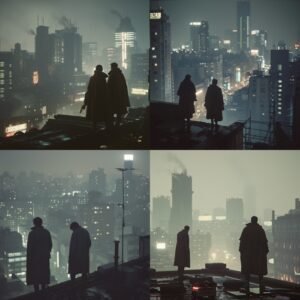We tested RunwayML Gen 3 a couple a weeks ago. Today, I wanted to experiment to see how well RunwayML can replicate iconic scenes from movies and TV shows. Our subjects? The neon-lit cyberpunk world of The Matrix, the intricate clockwork intro credits of Game of Thrones, and the charming 2D animation of Winnie the Pooh.
The Matrix: Neon Nights and Silhouetted Figures
Prompt:
A wide-angle view reveals a sprawling cityscape at night. Neon lights flicker in the distance as the camera slowly pulls back. Two silhouetted figures stand on a rooftop edge, their coats rippling in the wind. The silhouetted figures wear flowing trench coats over sleek, form-fitting attire, with heavy boots and possibly sunglasses, their outfits blending stylishly. The scene fades to black as haunting electronic music swells, leaving the audience with a sense of both resolution and impending conflict.
RunwayML’s Output:
RunwayML did an impressive job capturing the essence of The Matrix. The wide-angle cityscape was filled with flickering neon lights, giving off that unmistakable cyberpunk vibe. The silhouetted figures, with their trench coats and sleek attire, stood against the backdrop of the city, their outfits blending seamlessly into the scene. The atmosphere was moody and tense, although with a somewhat cleaner and more polished look than the gritty original. This slight difference in style added a unique touch but maintained the core feel of the scene.
Game of Thrones: Clockwork Wonders
Prompt:
An intricate clockwork map springs to life, gears turning. The camera sweeps across miniature kingdoms rising from the terrain. Iconic locations emerge: King’s Landing’s spires, Winterfell’s stone walls, The Wall’s icy expanse. Golden rings orbit a fiery sun, casting shadows. Banners of great houses unfurl as the stirring theme swells. The mechanical marvels assemble and disassemble, revealing the complex world of Westeros in constant motion.
RunwayML’s Output:
The recreation of the Game of Thrones opening sequence was both impressive and slightly eerie in its similarity. RunwayML managed to capture the detailed clockwork mechanisms and the grandeur of iconic locations like King’s Landing and Winterfell. The moving parts and sweeping camera angles closely mirrored the original sequence. Does this mean the model had been trained on similar visuals, raising interesting questions about the uniqueness and originality of AI-generated content? Even so, the mechanical marvels and dynamic assembly of the world of Westeros were beautifully rendered but again much cleaner.
Winnie the Pooh: A Stroll in the Garden
Prompt:
A 2D Winnie the Pooh ambles into his quaint garden, golden fur glowing in soft sunlight. A gentle tracking shot follows as he waddles past colorful flower beds and buzzing beehives. His red shirt stands out against the lush greenery. The camera pans to reveal a worn “Mr. Sanders” sign, honey pots scattered about, and a cozy treehouse nestled in the background. Butterflies flit by as Pooh approaches his favorite thinking spot.
RunwayML’s Output:
You can be sure Runway didn’t train its model on Disney. While this scene provided a contrast to the previous two. RunwayML’s attempt at recreating the 2D animation style of Winnie the Pooh was charming but totally different. The golden fur of Pooh and the soft sunlight in the garden were well-captured, evoking the warmth and simplicity of some other higher-res world. However, the differences in style were more pronounced here, as the AI struggled to the hand-drawn quality of the classic cartoon.


Our experiment with RunwayML has shown that while AI can come remarkably close to replicating the style of iconic scenes from movies and TV shows, it still adds its own subtle nuances and style as not to look too much like the original.
As AI continues to evolve, its role in creative industries will expand, offering new possibilities for content creation and artistic expression. If you’re curious about what AI can do, I encourage you to try RunwayML yourself. It’s fun and it likely free to test.

Christopher lives in Vermont with his wife, twin boys, border collie and corgi. He has owned a film production company, sold slot machines, and worked for Tony Robbins. He writes in his magical tiny house and sometimes writes in his blog at chrisrodgers.blog
Visit his author’s page.